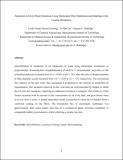Separation of oil-in-water emulsions using electrospun fiber membranes and modeling of the fouling mechanism
Author(s)
Choong, Looh Tchuin; Lin, Yi-min; Rutledge, Gregory C
Downloadjms-14-1828r2-ms.pdf (6.252Mb)
PUBLISHER_CC
Publisher with Creative Commons License
Creative Commons Attribution
Terms of use
Metadata
Show full item recordAbstract
Microfiltration of emulsions of oil (dodecane) in water using electrospun membranes of poly(trimethyl hexamethylene terephthalamide) (PA6(3)T) is demonstrated. Rejection of the emulsified dodecane increased from (4.3±0.9)% to (85±5)% when the ratio of droplet diameter to fiber diameter (dp/df) increased from 0.57±0.04 to 2.5±0.4, respectively. The normalized flux (relative to the pure water flux) decreased in proportion to the increase in emulsified oil concentration. The variations observed in flux with time are well-described by models in which the oil fouls the membrane, imparting an additional resistance to transport. The resistivity of the foulant increased with an increase in the concentration of oil in the feed, and grew fastest when dp/df was close to unity. A foulant deposition model is proposed in which the oil droplets form a conformal coating on the fibers. The normalized flux of electrospun membranes was approximately three times higher than that of a commercial phase inversion membrane of comparable bubble point diameter, while exhibiting a similar rejection.
Date issued
2015-03Department
Massachusetts Institute of Technology. Department of Chemical Engineering; Massachusetts Institute of Technology. Department of Materials Science and EngineeringJournal
Journal of Membrane Science
Publisher
Elsevier
Citation
Choong, Looh Tchuin (Simon); Lin, Yi-Min and Rutledge, Gregory C. “Separation of Oil-in-Water Emulsions Using Electrospun Fiber Membranes and Modeling of the Fouling Mechanism.” Journal of Membrane Science 486 (July 2015): 229–238 © 2015 Elsevier B.V.
Version: Author's final manuscript
ISSN
0376-7388